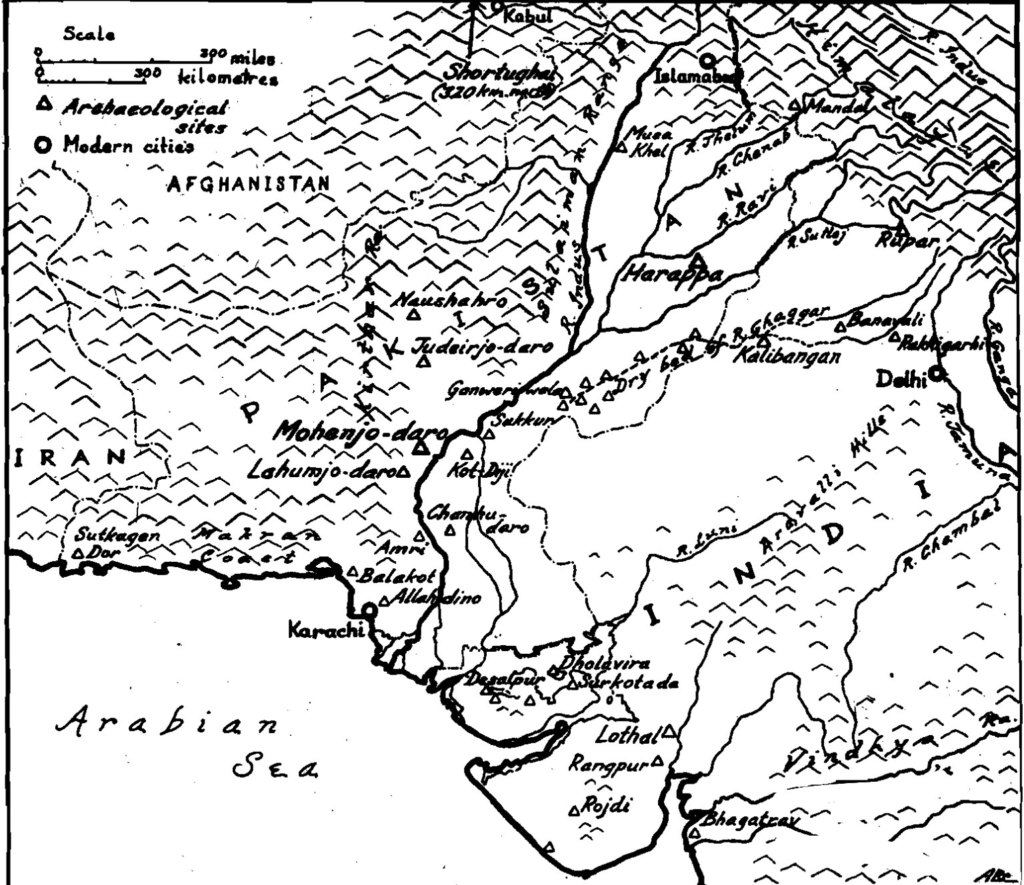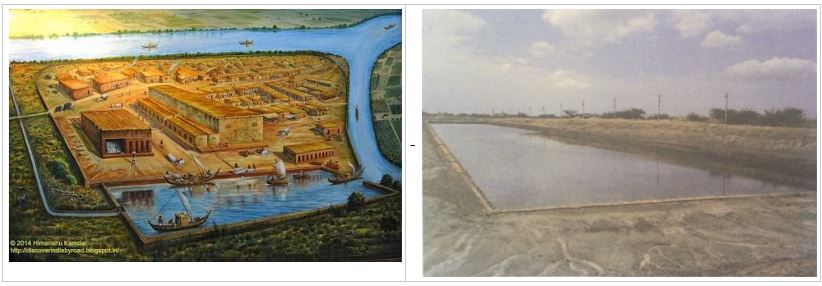Table of Contents
Indus Valley Architecture
This article deals with topic titled ‘Indus Valley Architecture .’ This is part of our series on ‘Culture’ . For more articles , you can click here
Introduction
- Sophisticated town planning with flourishing urban structure
- Well planned grids with broad main roads & smaller lanes intersecting at right angles
- Sophisticated drainage system
- Houses were made of bricks

Characteristics of Town planning
1 . Grid pattern
- Cities were laid out in grid pattern
- Streets oriented from East to west with broad main roads & smaller lanes intersecting at right angles
2. City walls / Fortified Cities
- Harappan Cities were fortified
. Fortification serves two purposes.
- It exclude outsiders and the underprivileged.
- They indicate that communities inside had something to protect.
Thus it give clue to socio-political hierarchy. It helps the powerful to control activities inside the fortification. It also helps them keep an eye on the outsiders. If traders bring goods from places faraway they can collect their share for allowing them access to potential buyers inside the fortification
3. Acropolis & lower cities
Typical city would be divided into two sections ,each fortified separately
| Acropolis / Citadal | – Located on artificially raised mound – Important buildings like Assembly Halls , Religious Structures , Granaries , Great bath of Mohenjodaro situated here |
| Lower section | – On level ground – Housing for inhabitants |
4. Residential buildings
- People lived in houses of different sizes ie stratification was present in society
- Opening of houses never in main streets
- Staircases was present – may have led to roof
- Floors made of high packed earth often replastered or covered with sand
- Roofs often made with timber beams
- Clay models of houses show that doors were sometimes carved or painted with simple designs
- Small houses attached to large ones may have been quarters of service groups working for wealthy city dwellers
- Toilets & Bathrooms – many houses or group of houses had separate bathing & toilet areas . Floor of these was made of tightly fitted bricks . Although some people may have relieved themselves outside city but toilet was present in almost all houses especially in Harappa
- Houses were without much decoration. In general it was plain & un-decorative. This shows utilitarian outlook of Harappan people .
5. In -house wells
- House had its own wells, drains & bathrooms
- In house well is a common & recognisable feature of Indus Valley civilisation
6. Drainage system
- Impressive drainage system : It was the most complete ancient system as yet
discovered.
- Every house was connected to the street drains.
- Main channels were made of bricks set in mortar and were covered with loose bricks that could be removed for cleaning.
- House drains first emptied into a sump or cesspit into which solid matter settled while waste water flowed out into the street drains
- Sewage chutes & pipes were separate from drains for collecting rain water
- Drainage systems were not unique to the larger cities, but were found in smaller settlements as well. Eg : At Lothal , while houses were built of mud bricks, drains were made of burnt bricks.
7. Great Bath
- Rectangular measuring 14.5X7 m & 2.4 m deep at Mohenjodaro . Wide staircase leads down into tank from North & South . It was made water tight by finely fitted bricks . But purpose of the Great Path is matter of debate
| Irfan Habib | Was meant for only elite class (not for common people) |
| DK Chakraborty | Was equivalent of tank accompanying a typical Hindu temple where one takes ritual dip before entering temple |
There are series of rooms along the eastern edge of buildings. One of them has well that may have supplied water to the tank

8. Dockyard
Huge Basin / Dockyard that was placed in centre of city & measured 770 feet in length & 120 feet wide & 15 feet deep with two openings on each side . Most probably it was used for docking ships ( but some historians feel that Basin was water reservoir for irrigation or for use of city )

9. Granaries
- Largest building at Mohenjodaro (150ft long 75ft wide 15ft high )
- Well ventilated
- Used to store surplus grains and indicate centralized control
10. Pottery
- Red and black pottery .
- Red to paint the background and
- Black colour to draw the designs of trees, birds , animals , human figures , other geometric patterns
- Mainly wheel made . Very few hand made
Use of pottery
- Utilitarian : Used in household purposes like storing water and food grains , cook food , eat food etc
- Decoration : Vessels with designs were for decoration purpose

11. No temples
12. Cemeteries
- Disposal of the dead has been an important religious activity of the human group . This is because the attitude towards the dead is linked up with the human beliefs regarding this life & life after death. Harappan civilisation hasn’t yet yielded a monument for the dead who could equal Pyramids of Egypt or Royal Cemetery of the Mesopotamian city of Ur
- Archaeologists generally use certain strategies to find out whether there were social or economic differences among people living within a particular culture. These include studying burials. Some graves contain pottery and ornaments, perhaps indicating a belief that these could be used in the afterlife. Jewellery has been found in burials of both men and women. In some instances the dead were buried with copper mirrors. But on the whole, it appears that the Harappans did not believe in burying precious things with the dead
- Located at sites eg Harappa , Kalibangan , Lothal , Rakhigarhi & Surkotda. In this, Harappa has maximum burials and require particular study.
- Types of burials
| Common | – Place body of deceased in extended position with head in north – Simple pit or Brick chamber – Grave goods include food, pottery , tools but they were never too lavish |
| Symbolic Burials | – With grave goods but no skeletons – Found at Kalibangan |
| Fractional burials | – Body exposed to elements & bones then gathered and buried – In Harappa & Mohenjodaro – These two sites also have urn burials – suggestive of cremation |
| Urn Burials | – Body burned and then ash placed in Urn and buried – In Harappa & Mohenjodaro |
| Multiple Burials | Of male & female Discovered at Lothal |
- A study at Kalibangan show different kind of burials found at same settlement. This shows different kind of religious beliefs & practices even in the same settlement.
Side Topic : Water Management System of Indus Valley Civilization
- Ancient Indus Systems of sewerages and drainage that were developed & used in cities throughout Indus Region were far more advanced than any found in contemporary urban sites in the Middle East
- Within the city, individual homes or groups of homes obtained water from wells. From a room that appears to have been set aside for bathing, waste water was directed to covered drains, which lined the major streets.
| Mohenjodaro | – Almost all houses had private wells (700 wells found in city) – Great Bath also found there |
| Lothal | Port at the Arabian Sea with a dockyard |
| Dholavira | – System of water management was architectural marvel which was crucial in an area, which is prone to frequent droughts. – Rain water in the catchment areas of the two seasonal streams – Manhar and Mansar – was dammed and diverted to the large reservoirs within the city walls. – Apparently, there were 16 water reservoirs within the city walls, covering as much as 36 percent of the walled area. |
| Shortughai | Canal for irrigation of fields drawing water from nearby Kokcha river |
